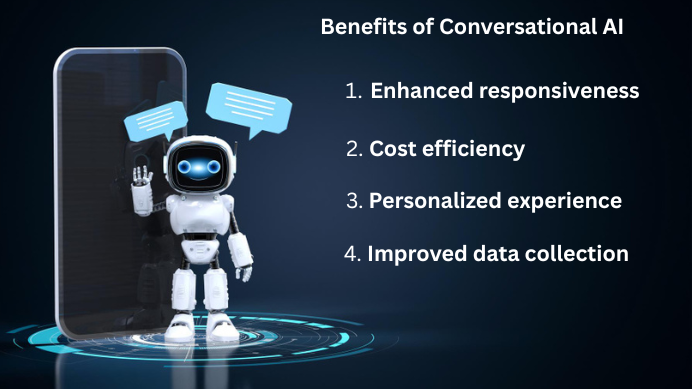
Conversational AI: Technologies, Process, and Benefits
As the name suggests, conversational AI refers to technologies that mimic and engage in human-like conversations. AI systems are programmed with algorithms to allow them to emulate human-like dialogues. This is achievable through the utilization of NLP, one of the branches of AI. By utilizing AI tools, it is easier to capture and comprehend a person’s speech, making dialogues between humans and machines easier and more user-friendly.
Conversational AI, though stirring changes in AI technologies to come, offers cost-friendly options for its customers. It helps to automate business operations, provide 24/7 customer care services to resolve inquiries, allow for in-depth personal interaction, and boost user involvement.
Without a doubt, conversational AI provides benefits for users on a global scale, allowing businesses to automate response tools with flexible service options. Furthermore, by increasing the adaptability of AI programs to targeted service branches, companies can improve their performance in real time.
In simple terms, conversational AI systems are technologies that respond with either speech or text in an email or on a mobile device. It is a simple way of talking with machines that replaces keyboards and touch screens.
What are the key technologies behind conversational AI?
Some of the key technologies behind conversational AI include the following
1. Natural language processing
NLP is perhaps one of the most important components of conversational AI technology because it provides machines with the ability to understand and interpret human language.
The ultimate goal of NLP is to break complex queries into manageable pieces of information that can be processed meaningfully, and this is achieved through tokenization, parsing, and semantic analysis. These steps allow the system to capture what users say and respond accordingly.
NLU and NLG are the constituent building blocks of NLP. NLU looks into extracting the meaning from the sentence and gathers clarity, while NLG pertains to the process of formulating answers and generating output. Both these components work to help the AI systems conduct effective interactions with users.
2. Machine learning
Another important component of conversational AI is machine learning. Users’ interactions with the systems provide the data needed for the development. Through the use of advanced algorithms, machine learning systems are able to analyze user behavior, so AI adjusts accordingly. Integrating more information into these systems over time enables them to refine the system’s decisions.
To improve the effectiveness of conversational AI, machine learning plays an important role in identifying user behavior and preferences. The process improves the accuracy of responses and helps AI to anticipate user needs.
3. Natural language generation
Natural Language Generation, or NLG, is a subfield of AI concerned with producing human-like language from structured data. NLG algorithms facilitate sophisticated and intuitive dialogue by deriving text from input data that adheres to and correlates with natural conversations.
Through templates and data inputs, conversational AI systems achieve astounding results with regard to sentence production that mimic human speech. With such capabilities, user interactions become more captivating and rewarding, thereby improving user satisfaction.
How does conversational AI work?
Conversational AI operates using Natural Language Processing (NLP), machine learning, and natural language generation. It all starts with input generation, where user queries are collected and examined with the help of NLP techniques. This analysis incorporates syntactic and semantic processing to capture the intention as well as the context of the user.
The system first analyzes the input, after which it utilizes machine learning algorithms to formulate appropriate context-based responses. User intent understanding is fundamental in this step. This is improved and enhanced with Generative AI since it utilizes past interactions in responding to users by continually learning and improving accuracy over time.
Subsequently, the system constructs a seamless conversational flow to answer user queries. Additionally, AI needs constant performance refinement so it can respond like a human. Regular system testing and feedback from users are essential during these processes.

What are the benefits of conversational AI?
Conversational AI has a number of technological benefits for both companies and customers alike.
1. Enhanced responsiveness
Every customer is treated as a unique case with specific needs, utilizing their very own chatbots and virtual assistants that provide on-demand and non-stop support. They don’t have to worry about waiting in line to get assistance, as virtual assistants provide them with instant service.
2. Cost efficiency
By automating repetitive and routine tasks, conversational AI significantly reduces the need for large customer service teams, lowering operational costs related to staffing, training, and infrastructure.
3. Personalised customer experience
Higher satisfaction rates can be achieved through the provision of distinct SSI, seamlessly organized via Natural Language Processing and Machine Learning. Systems can interpret user requests and remember what was told to them in the past, thus recommending more fitting items tailored to users.
4. Improved data collection and insights
Conversational AI collects and analyzes data from customer interactions in real time, offering valuable insights into customer behavior, preferences, and pain points. This information can inform business strategies and improve products or services.
What are the types of conversational AI?
Conversational AI solutions come in various forms, each designed to meet specific needs and use cases.
1. AI chatbots
AI chatbots are software programs designed to mimic human-like messaging interactions. They are great conversational AI examples, providing users with personalized experiences. These chatbots can be integrated into social media, messaging services, websites, and mobile apps, allowing businesses to engage with customers across multiple platforms.
2. Virtual assistants
Virtual assistants are one of the best conversational AI examples that is designed to assist users through voice recognition and natural language. Recognizing voice commands and executing tasks based on user intent, virtual agents provide hands-free operation and enhance user engagement.
These assistants can handle complex queries and offer efficient interactions, making them valuable tools for users seeking convenience and efficiency. The ability to recognize and process voice commands makes virtual assistants ideal for various applications, from managing personal tasks to providing customer support.
3. Voice assistants
Voice assistants provide hands-free interaction, significantly improving user convenience and accessibility. These assistants are designed to facilitate user interaction through voice commands, making technology more accessible and user-friendly.
Using advanced NLP and machine learning technologies, voice assistants understand and respond to user queries accurately, providing relevant information and support.
Applications of conversational AI
Conversational AI can be applied in numerous industries through conversational AI applications.
1. Customer support automation
In conversational AI, automation reduces the customer service workforce required, and therefore, expenditures.
With a good conversational AI platform, tools, training, and infrastructure for chatbots and voice assistants are provided so that they can be integrated smoothly with customer support software and channels of digital support, and not face any hurdles. Also, utilizing conversational AI platforms can improve the overall user experience.
2. HR and IT support automation
HR and IT functions make tremendous use of conversational AI with the streamlining of operations that repetitive task automation brings alongside improved effectiveness. In HR, the onboarding of new employees is now automated through conversational AI and is better for the employees.
In IT service management, problems of a technical nature can be solved by conversational AI technology, in addition to details about IT services and supervision of service requests being provided. The dialogue management in HR and IT not only enhances efficiency but also improves employee and customer satisfaction.
3. Conversational commerce
Conversational AI can streamline the shopping process without human intervention. With insights into customer preferences and behavior, conversational AI helps brands to tailor offerings.
By automating communication with customers, conversational AI will improve the shopping experience. This feature helps in driving sales and enhancing customer engagement.
How to implement a conversational AI strategy?
Implementing a successful conversational AI strategy involves several critical steps. Let’s look at some of them.
1. Define goals and use cases
Identifying clear objectives and specific outcomes is crucial for the successful implementation of conversational AI. Businesses should specify customer service KPIs and design the conversational flow of AI systems to ensure they meet their strategic objectives.
2. Choose the right platform
Selecting the right conversational AI platform is essential for integrating AI with existing business systems. Businesses should consider no-code or low-code solutions if they have limited development resources and understand the costs and timelines associated with implementation.
3. Measure performance and optimise
Regular analysis of customer interaction data is necessary to enhance the effectiveness of conversational AI systems. Monitoring performance metrics helps ensure these systems meet business objectives and provides a high level of user satisfaction.
Continuous optimization based on performance data and user feedback is essential for maintaining a competitive edge and improving operational efficiency. We must continuously learn to adapt to changing market conditions.
Conversational AI vs Generative AI: What are the differences?
The key differences between Conversational AI and Generative AI include the following.
1. Purpose and function
- Conversational AI: To facilitate human-like interactions between machines and people, Conversational AI is used. Here, the goal is to learn how to respond to user inputs conversationally. This is ideal for chatbots, customer service applications, and virtual assistants.
- Generative AI: Creating new and original content, including images, text, and audio, the generative AI model is perfect. Its functionality is based on patterns learned from big datasets. From writing articles to producing artwork, generative AI has come a long way in improving the productivity of the user.
2. Work process
- Conversational AI: This type of AI model relies on NLP and machine learning. Trained on datasets, they interpret language, learn context, and ensure seamless communication with the user.
- Generative AI: This uses advanced neural networks (such as transformers or GANs) to identify patterns in diverse datasets. They generate new content that is original. It is not limited to conversation and can produce creative outputs across various formats.
3. Interaction style
- Conversational AI: This AI-powered technology engages users in real-time, reciprocal dialogues, providing contextually relevant responses to user queries.
- Generative AI: Based on user-generated prompts, generative AI produces new content. However, they have a limitation in engaging in ongoing conversation. Based on prompts, but does not necessarily engage in ongoing conversation. The interaction is one-way, ensuring content delivery rather than dialogue.
As brands overcome the challenges and receive opportunities brought by conversational AI, they can’t deny the importance of selecting a robust and intelligent product. Organizations require scalable solutions that can bring customer engagement and scale business operations.
To help you in this regard, consider partnering with iTCart, a Digital Transformation and AI automation company that specializes in offering customized AI solutions. One of their verticals, called AiX Hub, facilitates open communication between people and machines through its AI chatbot. The platform offers guidance, support, and assistance to employees within an organization. You can also get access to resources, information, and tools, promoting a continuous learning environment.






